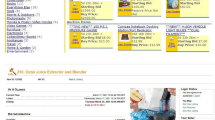Abstract
What factors make individual bidders pay more or less for the same item in online auctions? We use data on over 55,000 bids over a three-year period collected by a customized Internet software agent. These data are used to perform a within-bidders quasi-experiment, testing bidders who bid on the exact same item at different times during a 30-day period in online auctions. With theories from information systems and consumer behavior as our theoretical lens, we then examine factors that make individuals pay more for the exact same item in online auctions. We find that the same individual will tend to pay more for items sold on a weekend, for items with a picture, and for items sold by experienced sellers. We also find that the same individual is willing to pay more for the same item if others express an interest in that item, exhibiting a type of herd effect. Our results are generalizable to other auctions, and shed light on electronic commerce sales in general, where firms try to sell products for the highest possible price.
Similar content being viewed by others
References
S. Athey and J. Levin, Information and competition in U.S. forest service timber auctions, The Journal of Political Economy 109(2) April (2001) 375–417
S. Ba and P.A. Pavlou, Evidence of the effect of trust building technology in electronic markets: price premiums and buyer behavior, MIS Quarterly 26(3) September (2002) 243–268
J.P. Bailey, Intermediation and Electronic Markets: Aggregation and Pricing in Internet Commerce. Ph.D. Dissertation, Program in Technology, Management and Policy, MIT, Cambridge, MA, May 1998
J.Y. Bakos, Reducing buyer search costs: implications for electronic marketplaces, Management Science 43(12) December (1997) 1676–1692
Y. Bakos, Towards friction-free markets: the emerging role of electronic marketplaces on the internet, Communications of the ACM 41(8) August (1998) 35–42
R. Bapna, When snipers become predators: can mechanism design save online auctions? Communications of the ACM 46(12) (2003) 152–158
R. Bapna, P. Goes and A. Gupta, A theoretical and empirical investigation of multi-item on-line auctions, Information Technology and Management 1(1–2) January (2000)1–23
R. Bapna, P. Goes and A. Gupta, Online auctions: insights and analysis, Communications of the ACM 44(11) November (2001) 42–50
C. Beam and A. Segev, Auctions on the internet: a field study, Working paper 96-WP-1019, Fisher Center for Management and Information Technology, Haas School of Business, University of California, Berkeley, CA, 1998
D.A. Belsley, E. Kuh and R.E. Welsch, Regression Diagnostics: Identifying Influential Data and Sources of Collinearity (John Wiley & Sons, New York, NY, 1980)
J. Biddle, A bandwagon effect in personalized license plates? Economic Inquiry 29(2) April (1991) 375–388
J. Bulow, M. Huang and P. Klemperer, Toeholds and takeovers, Journal of Political Economy 107(3) June (1999) 427–454
D.W. Dahl, A. Chattopadhyay and G.J. Gorn, The use of visual mental imagery in new product design, Journal of Marketing Research 26(1) February (1999) 18–28
C. Dellarocas, Analyzing the efficiency of eBay-like online reputation reporting systems, in: proceedings of the Third ACM Conference on Electronic Commerce, Tampa, FL (October 14–16, 2001)
R.A. Feldman and R. Mehra, Auctions: theory and applications, in: International Monetary Fund Staff Papers (Washington, DC, September 1993)
W.H. Greene, Econometric Analysis, 4th ed. (Prentice Hall, Englewood Cliffs, NJ, 1999)
J.A. Hitchcock, Uncle griff at eBay, Link-up 17(2) March/April (2000) 14
R.J. Kauffman, S.T. March and C.A. Wood, Design principles for long-lived internet agents, International Journal of Intelligent Systems in Accounting, Finance and Management 9(4) December (2000) 217–236
R.J. Kauffman and C.A. Wood, The effects of shilling on final bid prices in online auctions, Electronic Commerce Research and Applications 4(1) Spring (2005) 21–34
P. Kennedy, A Guide to Econometrics, 4th ed. (MIT Press, Cambridge, MA, 1998)
O. Koppius and E. van Heck, The role of product quality information, market state information and transaction costs in electronic auctions, Working paper, Department of Decision and Information Sciences, Rotterdam School of Management, Erasmus University, Rotterdam, Netherlands, January (2002)
H.G. Lee, Do electronic marketplaces lower the price of goods? Communications of the ACM 41(1) January (1998) 73–80
D. Lucking-Reiley, D. Bryan, N. Prasad and D. Reeves, Pennies from eBay: the determinants of price in online auctions, Working paper, University of Arizona, Tucson, AZ, April (2005)
P.R. Milgrom, Auctions and bidding: a primer, Journal of Economic Perspectives 3 (1989) 3–22
P.R. Milgrom and R.J. Weber, A theory of auctions and competitive bidding, Econometrica 50(5) September (1982) 1089–1122
A.V. Muthukrishnan and F.R. Kardes, Persistent preferences for product attributes: the effects of the initial choice context and uninformative experience, Journal of Consumer Research 28(1) June (2001) 89–104
J. Neter, M.H. Kutner, C.J. Nachtsheim and W. Wasserman, Applied Linear Statistical Models, 4th ed. (Irwin Press, Chicago, IL, 1996)
E. Pincker, A. Seidmann and Y. Vakrat, Managing online auctions: current and business issues, Management Science 49(11) November (2003) 1457–1484
J.G. Riley and W.F. Samuelson, Optimal auctions, American Economic Review 71(3) June (1981) 381–392
S. Segan, Coin World Guide to U.S. Coins: Prices and Value Trends (North American Library/Signet, Penguin Putnam, New York, NY, 2002)
J. Tirole, The Theory of Industrial Organization (MIT Press, Cambridge, MA, 1988)
S. Tschantz, P. Crooke and L. Froeb, Mergers in sealed versus oral auctions, International Journal of the Economics of Business 7(2) July (2000) 201–212
Y. Vakrat and A. Seidmann, Can Online Auctions Beat Online Catalogs? In: Proceedings of the 20th International Conference on Information Systems (ICIS 1999), P. De and J. DeGross (eds.) (Charlotte, NC, 1999)
Y. Vakrat and A. Seidmann, Implications of the Bidders’ Arrival Process on the Design of Online Auctions, in: Proceedings of the 33rd Hawaii International Conference on Systems Science (HICSS), R. Sprague (ed.) (Maui, HI, IEEE Computing Society Press, Los Alamitos, CA, January2000)
W. Vickery, Counter-speculation auctions and competitive sealed tenders, Journal of Finance 41 (1961) 8–37
J. Wade, Dynamics of organizational communities and technological bandwagons: An empirical investigation of community evolution in the microprocessor market, Strategic Management Journal 16(Special Issue) Summer (1995) 111–133
E.J. Warner and R.B. Barsky, The timing and magnitude of retail store markdowns: Evidence from weekends and holidays, Quarterly Journal of Economics 110(2) May (1995) 321–352
W.L. Wilkie, Consumer Behavior, 3rd ed. (John Wiley & Sons, New York, NY, 1994)
J.F. Yates, Judgment and Decision Making (Prentice Hall, Englewood Cliffs, NJ, 1990)
Author information
Authors and Affiliations
Corresponding author
Rights and permissions
About this article
Cite this article
Kauffman, R.J., Wood, C.A. Doing their bidding: An empirical examination of factors that affect a buyer’s utility in Internet auctions. Inf Technol Manage 7, 171–190 (2006). https://doi.org/10.1007/s10799-006-9181-4
Issue Date:
DOI: https://doi.org/10.1007/s10799-006-9181-4




